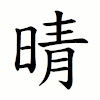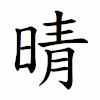晴
| ||||||||
 | ||||||||
| ||||||||
| ||||||||
Translingual
| Stroke order (Chinese) | |||
|---|---|---|---|
 | |||
| Stroke order (Japan) | |||
|---|---|---|---|
 | |||
Han character
晴 (Kangxi radical 72, 日+8, 12 strokes, cangjie input 日手一月 (AQMB), four-corner 65027, composition ⿰日青)
References
- KangXi: page 496, character 39
- Dai Kanwa Jiten: character 13994
- Dae Jaweon: page 863, character 10
- Hanyu Da Zidian (first edition): volume 2, page 1515, character 7
- Unihan data for U+6674
- Unihan data for U+FA12
- Unihan data for U+FA91
Chinese
| trad. | 晴 | |
|---|---|---|
| simp. # | 晴 | |
| 2nd round simp. | 𰕺 | |
| alternative forms | 夝 星 暒 精 | |
Glyph origin
Characters in the same phonetic series (生) (Zhengzhang, 2003)
| Old Chinese | |
|---|---|
| 猜 | *sʰlɯː |
| 輤 | *sʰleːns |
| 綪 | *sʰleːns, *ʔsreːŋ |
| 倩 | *sʰleːns, *sʰleŋs |
| 棈 | *sʰleːns |
| 蒨 | *sʰeːns |
| 篟 | *sʰeːns |
| 生 | *sʰleːŋ, *sreŋs |
| 牲 | *sreŋ |
| 笙 | *sreŋ |
| 甥 | *sreŋ |
| 鉎 | *sreŋ, *sleːŋ |
| 珄 | *sreŋ |
| 鼪 | *sreŋ, *sreŋs |
| 猩 | *sreŋ, *seːŋ |
| 狌 | *sreŋ |
| 眚 | *sreŋʔ |
| 貹 | *sreŋs |
| 崝 | *zreːŋ |
| 精 | *ʔsleŋ, *ʔsleŋs |
| 菁 | *ʔsleŋ |
| 鶄 | *ʔsleŋ, *sʰleːŋ |
| 蜻 | *ʔsleŋ, *sʰleːŋ |
| 鼱 | *ʔsleŋ |
| 婧 | *ʔsleŋ, *zleŋs, *zleŋʔ |
| 睛 | *ʔsleŋ, *sʰleŋʔ |
| 箐 | *ʔsleŋ |
| 聙 | *ʔsleŋ |
| 旌 | *ʔsleŋ |
| 清 | *sʰleŋ |
| 圊 | *sʰleŋ |
| 請 | *sʰleŋʔ, *zleŋs, *zleŋ |
| 凊 | *sʰleŋs |
| 䝼 | *zleŋs, *zleŋ |
| 靚 | *zleŋs |
| 情 | *zleŋ |
| 晴 | *zleŋ |
| 夝 | *zleŋ |
| 靜 | *zleŋʔ |
| 靖 | *zleŋʔ |
| 睲 | *seŋʔ, *seːŋs |
| 惺 | *seŋʔ, *seːŋ |
| 性 | *sleŋs |
| 姓 | *sleŋs |
| 靗 | *l̥ʰeŋs |
| 鯖 | *ʔljeŋ, *sʰleːŋ |
| 青 | *sʰleːŋ |
| 靘 | *sʰleːŋ, *sʰleːŋs |
| 掅 | *sʰleːŋs |
| 胜 | *sleːŋ |
| 曐 | *sleːŋ |
| 星 | *sleːŋ |
| 鮏 | *sleːŋ |
| 腥 | *seːŋ, *seːŋs |
| 鯹 | *seːŋ |
| 醒 | *seːŋ, *seːŋʔ, *seːŋs |
| 篂 | *seːŋ |
Written as 夝 in Shuowen and as 星 in the Classic of Poetry.
Phono-semantic compound (形聲, OC *zleŋ) : semantic 日 (“sun”) + phonetic 青 (OC *sʰleːŋ).
Etymology
Baxter and Sagart (2014) propose that it is from 清 (OC *tsʰeŋ, “clear”) with the intransitivizing/stativizing prefix *N-. Compare Proto-Hmong-Mien *ntshji̯əŋ (“clear”), whence White Hmong ntshiab.
Alternatively, it is perhaps derived from 星 (OC *sleːŋ, “star”): "become starry" > "weather clearing during the night" > "clearing when the sun is coming out" (Schuessler, 2007).
Pronunciation
Definitions
晴
Compounds
Derived terms from 晴
Japanese
| Shinjitai | 晴 | |
| Kyūjitai [1] |
晴 晴or 晴+ ︀? |
 |
| 晴󠄀 晴+ 󠄀?(Adobe-Japan1) | ||
| 晴󠄃 晴+ 󠄃?(Hanyo-Denshi) (Moji_Joho) | ||
| The displayed kanji may be different from the image due to your environment. See here for details. | ||
Readings
References
- “晴”, in 漢字ぺディア (Kanjipedia) (in Japanese), 日本漢字能力検定協会, 2015—2023
Korean
Etymology
From Middle Chinese 晴 (MC d͡ziᴇŋ). Recorded as Middle Korean 쳐ᇰ (chyeng) (Yale: chyeng) in Hunmong Jahoe (訓蒙字會 / 훈몽자회), 1527.
Vietnamese
This article is issued from Wiktionary. The text is licensed under Creative Commons - Attribution - Sharealike. Additional terms may apply for the media files.